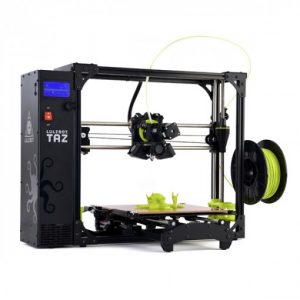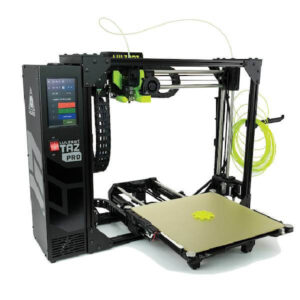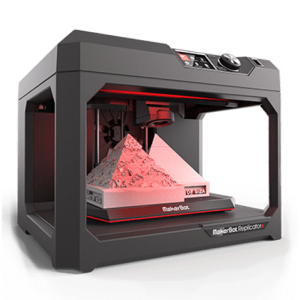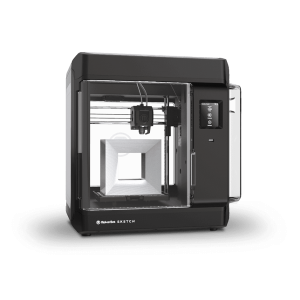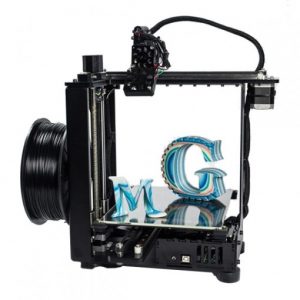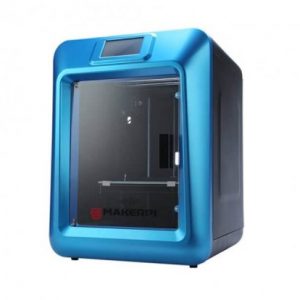Worldwide
Filter
Showing 121–150 of 260 results
PROS:
- 4.3 inch touch screen interface to ease out the interaction.
- Auxiliary leveling and humanized design.
- High-quality lattice glass easing bed adhesion.
- Top-quality blue Teflon tube resisting high temperatures.
- TMC ultra-quiet drive for silent, noise-proof operations.
CONS:
- Not only LK5 Pro but in general every open-bodied 3D printer has the problem of generating temperature as opposed to printers that host a print chamber.
- Setup is an issue if you are not used to many manual adjustments.
PROS:
- Supports filament break detection, resume printing after power loss and a stopped print and also supports online or TF card offline printing.
- 3.5-inch Touch LCD Screen.
- Support 7 languages - Chinese, English, German, Russian, Spanish, French, Italian.
- Integrated metal body design.
- Mute printing.
CONS:
- Open body of the 3D printer makes it hard for you to achieve the glass transition temperature of the filament material.
- Part quality is average.
PROS:
- The 3D printer is very reliable with a sturdy design
- The compact design is impressive
- Plug and play setup
- Automatic bed leveling
- Compatible with a large type of materials
- User-friendly user interface
- It offers a 20 percent larger build volume than its predecessor
- High print speed
CONS:
- Print quality with high speed isn’t very impressive
- Small build volume
PROS:
- PEI print surface
- Beginner’s friendly
- Sturdy Design
- Automatic calibration
- Auto-cleaning of nozzle
- Comprehensive documentation
- Reliable
- Open-source hardware, hence expandable
CONS:
- Missing LCD control
- Very Small build volume
- Requires a connection to the PC for operation
- Noisy
PROS:
- Lulzbot TAZ 6 has a huge build size i.e. (280 x 280 x 250 mm).
- The printer is reliable and gives consistent printing performance.
- The frame of the printer is solid, also it has a sturdy design.
- Lulzbot TAZ 6 is easy to use and setup.
- You can auto-calibrate this printer and self-clean the nozzle.
- The printer is open-sourced and hackable.
- You can do untethered printing on the PEI print surface.
CONS:
- The printer is priced much higher than others offering the same amount of features.
- Lulzbot TAZ 6 is slightly noisy.
- Has a limited user control when operated in untethered mode.
- You’d have to take a slow initial setting up the printer because of slicer issues.
PROS:
- E3D Titan Aero extruder
- Automatic bed leveling
- Automatic nozzle cleaning
- PEI coated heated print bed
- Large build space
- Great print quality
- Amazing print speed
- Pre-existing Filament profiles
- Filament run-out sensor
- Open-source Hardware
CONS:
- Missing WIFI connectivity
- No remote control
- Expensive
PROS:
- High speed
- High accuracy when printing
- Automatic bed leveling
- Automatic nozzle cleaning
- E3D extruder
- Heated Build surface
- PEI coated surface
- Swappable tool heads
CONS:
- Lack of Wifi Connectivity
- Expensive for home users
- No remote access
PROS:
- It’s a versatile 3D printer that is openly helpful to you to choose projects from the community.
- The printer’s scalable and smart.
- S600 D secures the operator from harmful fumes.
CONS:
- Part Quality produced by S600 D is a little bit of concern.
PROS:
- Automatic Z Calibration.
- Automatic Nozzle Calibration.
- Automatic Material Loading.
- Much of the printing system is completely automated thereby decreasing the overall inefficiency associated with the printer.
- The printer is also well integrated with the CAD software meaning that all the flaws in the design can already previously be viewed and disposed of at the correct moment.
CONS:
- The printer has a closed chamber which would mean that manual cooling would be needed after the part is printed. This would in turn lead to an increase in overall print time needed for an object.
PROS:
- Professional interface.
- Good PLA filament.
- Excellent software.
- Active user community.
- Plug and Play.
CONS:
- Clogged print heads.
- Acrylic build plate.
PROS:
- Smart extruder plus
- Compact
- Easy to set up (in just 10 minutes)
- Auto calibration
- Auto bed leveling
- Reliable
- Great customer support
- Removable build plate
CONS:
- No dual extruder
- Compatible only with PLA
- Does not support high temperature
- 100 microns precision
Best price
PROS:
- Sleek and can be used inside your house as well
- It is easy to set up with the help of instructions available on the mobile app
- WiFi connectivity available
- Remote monitoring is possible on mobile phones and tablets
- Nice print speed
- Larger build volume in comparison to its predecessor
CONS:
- Print Quality isn’t justified when put across the price tag the printer owns
- The USB port has connection issues
- Non-heated build plate causes warping
- Third-Party filament usage limitation
- Open Design and risky to use around kids and beginners
PROS:
- Build volume area is perhaps, one of the strongest advantages of buying this 3D printer. This spacious area has been mentioned a couple of times above too because it leverages a better advantage to the customers in the long run. This big space enables customers to print bigger items and offers a competitive advantage over other printers. It breaks barriers of normal limitations associated with 3D printers and exceeds their limits, especially in the case of consumer-focused printers.
- This 3D printer comes with a sophisticated design that has a 3.5” liquid crystal display, stronger connectivity options, inbuilt camera. Such a comprehensive design allows users to make better use of the technology available at their hands and deliver simple functionalities to them. Even though it has a bigger build area, it features a compact look. This compact look is encased in dimensions of 19.4” x 22.2” x 33.9”.
- This print is controlled through the use of either mobile or cloud applications. Such flexibility makes way for better accessibility to the end-users through all the printing stages and enables users to control features, power, and print types right from the comfort of their desk. The inbuilt camera allows users to continuously monitor different printing as well as connectivity phases. Such a comprehensive utility ensures that the customers are in true control of what goes behind during the printing process.
CONS:
- Forcefully making use of a 3rd party filament for printing purposes automatically voids a customer’s printer’s warranty.
- It only supports PLA.
Best price
PROS:
- You can maximize student innovation using this 3D printer setup. It gives you the facility as a teacher to combine hybrid classroom teaching with hands-on learning and unlock students’ creative potential with accessible printing merged with project-based learning.
- You can develop professionally, and gain confidence by following the fifteen hours of student curriculum with Design thinking and 3D printing. It provides you ISTE certification not only if you are a teacher, but also if you are a student. There is 3D printing integrated curriculum available for teachers that are applicable with PD credit.
- The printer allows you to have a 3D printing collaboration from anywhere. You do not necessarily need to be around the 3D printer. The free cloud-based software with Makerbot Cloud print can be integrated with Google classroom. It will allow you to design print integrations across familiar software such as Tinkercad, Fusion 360, and Onshape.
- By buying it, you avail the opportunity to join the largest 3D printing community of educators. Allow yourself to learn from curated lessons that are created by Makerbot Certified Educators and access more than 600 lesson plans across various grade levels and subjects.
CONS:
- Makerbot Sketch Classroom needs active participation from your end. Whether you are a student or a teacher, you will have to also search for new ways to work out with this 3D printer. Also, after a point of time, you’d realize that the printer will not be effective enough to print intricately designed parts and functional prototypes on it. It can provide a basis for those who do not know 3D printing at all. But if you are a user who is above it, this 3D printer is definitely not for you.
PROS:
- Reliable
- Open-source design
- Upgradable
- High precision
- Fast Speed
- Heated bed
- Four Point Bed leveling system
CONS:
- Costly for beginners
- Manual bed leveling
- Limited build space
PROS:
- High reliability
- Amazing print quality
- Great speed
- Multiple material support
- Metal frame for the sturdy body and better precision
- Heated build plate
- Advanced cooling of parts
- True leveling;12 months warranty
CONS:
- Expensive for home users
- Connectivity sometimes is not very smooth
PROS:
- Easy to setup
- True leveling
- Independent dual extruder
- Great print quality
- Higher reliability
- Professional print results
- The heated and removable print bed
- High nozzle temperature of up to 300 degrees Celsius
- Mimeo Mode
CONS:
- Expensive for home users and makers
PROS:
- Closed build-up
- Intelligent dual extruders
- Camera monitoring
- Touch probe automatic leveling
- Touch screen interface.
- Solid build plate that can withstand high temperatures
CONS:
- The price of the printer is very much compared to printers in the same range offering similar features
Editor choice
PROS:
- Greater build volume.
- Excellent Quality of prints.
- Touch screen interface.
- Integrated Camera.
CONS:
- Unstable while printing.
PROS:
- Reliable
- Accurate and precise
- High strength materials support
- Interactive touchscreen
- Intuitive scaling software
CONS:
- Manual calibration
- Not affordable for learning or fun
PROS:
- he complete system of Wash-1, Sinter-1, and 2 is a very big plus point for the printer.
- The printers work without getting a separate powder binding system in place and reduce the post-processing of parts and hence expedites the print speed.
CONS:
- There are no pictures of parts and functional prototypes that are manufactured using this 3D printer, so the only point from which you have to judge the printer's print quality is from the claimed layer resolution range.
PROS:
- Capable of building parts and functional prototypes that are ten times in strength than mainstream 3D printing materials.
- Excellent layer resolution range.
- Stable body.
- Very intuitive software.
CONS:
- Cost of 3D printing materials compatible with this 3D printer is very high than mainstream FDM 3D printing materials.
PROS:
- It lets you continuously print carbon fiber.
- Printing with a varied range of materials is possible.
- Huge build volume.
- Advanced hardware and software to give you a seamless user experience.
CONS:
- Post-processing of the parts and functional prototypes printed with the printer is difficult because of the closed print chamber.
PROS:
- Users can print two different objects parallelly
- The print speed is fast
- Massivit is accurate and can create complex designs without the hassle
- One can print support free models, even for non-vertical walls and ceilings
CONS:
- It is very expensive
- Prints in only its proprietary material
- Very huge in size
PROS:
- Monoprice Maker Select V2 is affordable.
- The print quality is average.
- This printer offers a large build area.
- Has a support team that is ready to help anytime i.e. before or after purchasing the printer.
CONS:
- Support structures used with this printer could be better than what they are.
- Setting the printer up requires a little more time than with other printers
PROS:
- Temperature settings can be nicely done because the printer has an enclosed area
- The print bed is easily removable
- Overall the frame of the printer is sturdy
CONS:
- The printer produces more noise than its competitors
- Seeing the price, the build area is small
PROS:
- The printer has a build volume that is unmatched in the price range it is listed in the market. This enables small businesses that cannot afford to buy printers which offer build volume also to print parts and functional prototypes of huge build volume
- Overall the printer is very easy to use and comes with a user-friendly touch screen interface
- MP Maker Pro MK1 comes with an auto bed leveling feature
- The print bed is positioned with the help of magnets that are liftable so removing of parts becomes easy
- This 3D printer has a steel construction that provides it a rigid structure that does not vibrate with the printing process is going on
CONS:
- Lower print speed
- Temperature adjustment for parts like ABS is an issue.
- The open frame is something that not many users like to rely upon
PROS:
- Available at an affordable cost.
- Has simple controls.
- Gives decent print quality.
CONS:
- USB connection is not reliable.
- Configuration with the software is a must.
PROS:
- It is easy to setup
- Reliable
- Heated build plate
- All metal hot end
- Padding material for the build plate
- Great print quality
- Affordable
CONS:
- Difficult to work with ABS
- Smaller build volume





